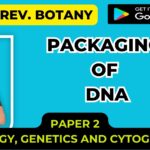![]()
FORMS OF DNA
CONFORMATIONAL FLEXIBILITY OF DNA MOLECULES:-
- The vast majority of DNA molecules present in the aqueous protoplast of living cells almost certainly exist in the living cells almost certainly exist in the Watson Crick double helix model.
- Another model content with the X-ray diffraction was constructed in which the two antiparallel DNA strands remain associated via. Complementary base pairing, but lie “side by side” instead of being wound into a continuous double helix.
- But the existence of a double helix has been confirmed by experiments to measure directly the number of base pairs per turn.
- This proves to be 10.4 instead of 10 bases paired by the classic B-model.
- The change requires a slight adjustment in the angle of rotation between adjacent base pairs along the helix, to 34.60
- So that it takes slightly longer to accomplish the full 3600 turns.
- Changes in the condition or in the particular base sequence could lead to lighter or looser helical structures in Particular regions. Indeed the structure of a particular 12 base pair molecule has been shown by X-ray crystallography to have 10.1 base pairs per turn, achieved by a slight twist of each base pair that improves base stacking relative to the original model.
- Because of this variation, the idea that there is a single structure for the DNA double helix has been replaced with a view that there are families of structures each of a characteristics type, but shows difference in the no. of nucleotides per turn and the distance between adjacent repeating units the variation is achieved by changes in the rotation of groups about bonds with rotational freedom.
- Thus the DNA molecule exhibit a considerable amount of conformational flexibility,
- Till today 6 forms of DNA molecule are Known but most of these have been found only under rigidly controlled experimental conditions., these forms are distinguished by:
- The no. of base pairs that occupy each turn of the helix.
- The pitch or angle between each base pair
- The helical diameter of molecule
- The bounded length of the double helix.
Some of these forms inter convert if salt and hydration conditions are manipulated.
B-FORM OF DNA: –
- This is the dominant form of DNA under physiologic condition has pitch of 3.4 nm per turns, 10 base pairs exist each planer base being stacked to resemble 2 binding stacks of coin sides by side.
- The 2 stacks are held together by hydrogen bonding at each level between the 2 coins on opposite stacks and by 2 ribbons would in a right handed turn about the 2 stacks and representing the phosphodiester back bone.
A- FORM OF DNA:-
- It is found in fibers at 75% relative humidity and requires the presence of Na+, K+ or Cesium as the counter ion.
- Instead of lying flat the bases are tilted with regard to the helical axis and there are more base pairs per turn.
- The A form is biologically interesting because it is probably very close to the conformation adopted by DNA-RNA hybrids or by RNA-RNA double stranded regions, the reason is that the presence of 2 hydroxyl groups prevents RNA from lying in the B form.
- In this form II nucleotides per turn are present.
C-FORM OF DNA: –
- This occurs where DNA fibers are maintained in 66% relative humidity in the lithium.
- It has fewer base pairs per turn than B-DNA. It has 91/3 no. of nucleotides base pairs per turn.
- Some further forms have been found that appear to represent options open only to DNA molecules with particular quick’s in their base composition.
D-FORM AND E-FORM OF DNA:-
- These are actually possibly extreme variants of the same form.
- They have the fewest base pairs per turn and are taken up only by certain DNA molecules that lack guanine.
Z-FORM OF DNA: –
- They are left handed double helix in which the phosphodiester backbone zigzags along the molecule hence the name Z-DNA.
- It is least twisted and it has only one grove. Z-DNA occurs in repeated sequences of alternating purines and pyrimidine deoxynucleotides but also requires one or more stabilizing influences.
- These stabilizing influences include
- The presence of high salt or specifications such as spermine or spermidine
- A high degree of negative supercoiling of DNA.
- The bending of Z-DNA specific protein.
- The methylation of 5-carbon comes from the deoxycytidine nucleotides in the alternating sequence.
- Z-DNA could exert regulatory effects both proximal and distal to the site of its existence.
- For instance, some proteins that bind in the major or minor groove of B form DNA could probably not bind to the Z-form .
- In addition, the reversion of Z-form to a B-form of DNA, an event that might occur as a consequence of low of CH3 group from 5-methyldeoxycytidine, would likely reveal in torsional difference of DNA actual to the actual site of the Z-DNA.
- The existence of Z-DNA in Drosophila chromosomes has been demonstrated utilizing antibodies that recognize and bind specifically to Z-DNA human DNA containing potential Z-DNA forming regions dispersed throughout the genome, and stabilizing influences may also exist.






